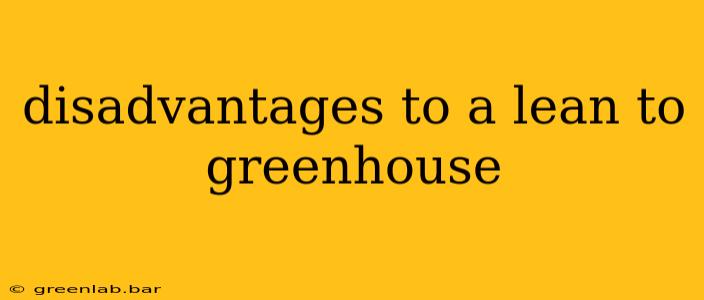Lean-to greenhouses, while offering affordability and ease of construction, aren't without their drawbacks. Understanding these limitations is crucial before embarking on a lean-to greenhouse project. This article explores the key disadvantages to help you make an informed decision.
Limited Space and Sunlight
One of the most significant disadvantages is the limited growing space they provide. Their design, attached to an existing structure, restricts both the length and width, often resulting in a smaller growing area compared to freestanding greenhouses. This can be particularly limiting for ambitious gardeners or those with large plant collections.
Furthermore, the angle of the lean-to significantly impacts sunlight exposure. While south-facing lean-tos (in the Northern Hemisphere) maximize sunlight during the winter months, the angle can lead to insufficient sunlight in the summer. The attached wall also casts a shadow, further reducing the amount of direct sunlight reaching your plants. This can hinder plant growth and yields, especially for sun-loving varieties.
Temperature Fluctuations
Lean-to greenhouses can experience greater temperature fluctuations than freestanding models. The attached wall acts as a heat sink, absorbing heat during the day and releasing it at night. This can lead to temperature swings that are detrimental to plant health, particularly in climates with significant temperature variations between day and night. Effective temperature regulation becomes more challenging and might necessitate more sophisticated climate control systems.
Structural Limitations
The structural integrity of a lean-to greenhouse is inherently linked to the building it's attached to. Any structural issues with the existing building can negatively impact the stability and longevity of the lean-to. Furthermore, the weight of the greenhouse, especially when filled with plants and water, adds stress to the wall. Ensuring the wall is strong enough to support the additional weight is crucial. Incorrect installation can lead to structural damage to both the lean-to and the existing building.
Access and Ventilation
Access can sometimes be limited in lean-to greenhouses. The attached structure might restrict access to certain areas, making planting, harvesting, and general maintenance more difficult.
Ventilation can also be a challenge. While vents and windows can be incorporated, the design often limits the options for adequate airflow, particularly when compared to freestanding greenhouses with multiple vents and gable ends. Poor ventilation can lead to increased humidity and the potential for fungal diseases.
Aesthetic Considerations
Finally, the aesthetic impact shouldn't be overlooked. A lean-to greenhouse might not aesthetically complement all homes or buildings. Careful consideration of its design and integration with the existing architecture is crucial to ensure it enhances rather than detracts from the overall appearance of the property.
Conclusion
While lean-to greenhouses provide a practical and budget-friendly solution for some gardeners, understanding their limitations is paramount. Careful consideration of factors like space, sunlight, temperature regulation, structural integrity, access, ventilation, and aesthetics is vital to determine if a lean-to greenhouse is the right choice for your specific needs and circumstances. Weighing these disadvantages against the advantages will help you decide if a lean-to is the best option for your gardening aspirations.

